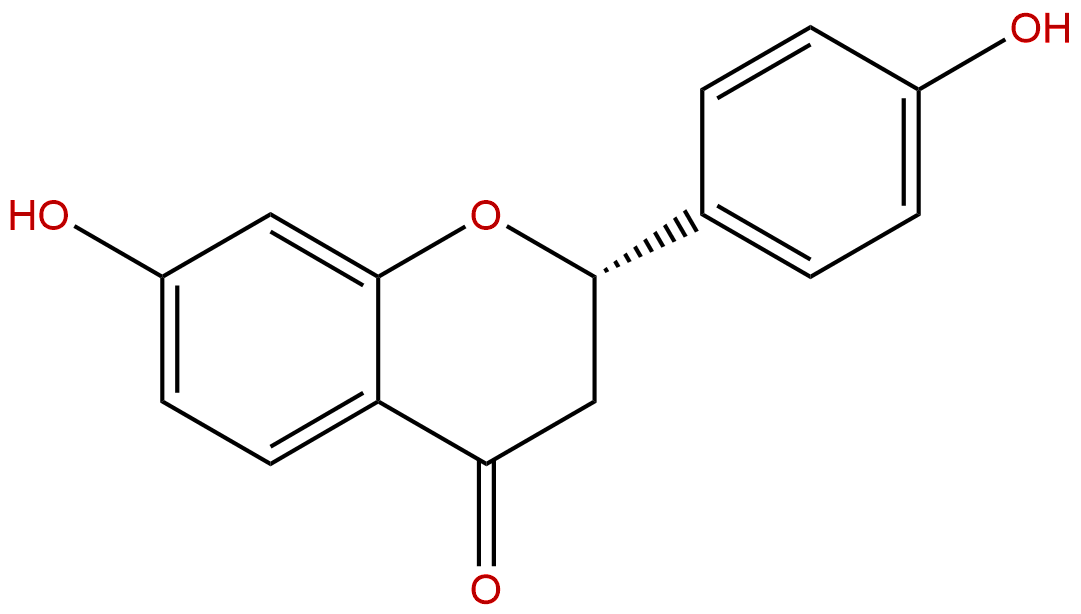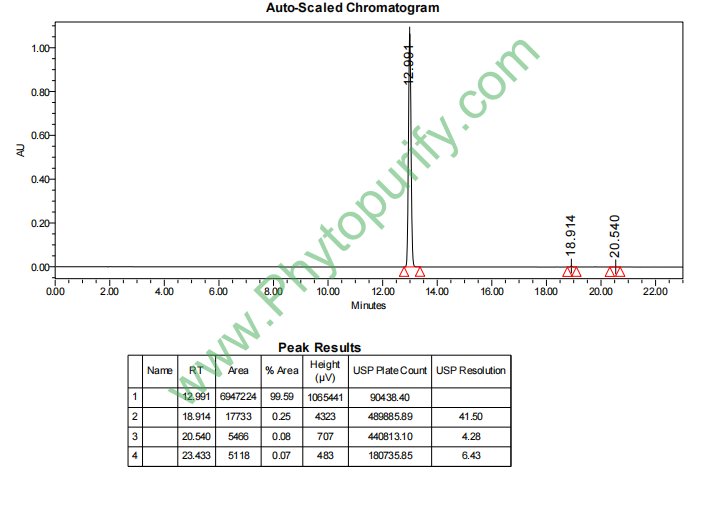
LiquiritigeninCAS No.:578-86-9
|
||||||||||
 |
|
|
||||||||

| Catalogue No.: | BP0873 |
| Formula: | C15H12O4 |
| Mol Weight: | 256.257 |
Product name: Liquiritigenin
Synonym name:
Catalogue No.: BP0873
Cas No.: 578-86-9
Formula: C15H12O4
Mol Weight: 256.257
Botanical Source: Centrolobium, Dalbergia, Medicago, Umtiza, Zollernia, Onobrychis, Myroxylon, Peltogyne, Glycyrrhiza, Cicer and Platymiscium (all Leguminosae). Also in Citrus
Physical Description: Cryst.
Type of Compound: Flavonoids
Purity: 95%~99%
Analysis Method: HPLC-DAD or/and HPLC-ELSD
Identification Method: Mass, NMR
Packing: Brown vial or HDPE plastic bottle
Storage: Store in a well closed container, protected from air and light. Put into refrigerate or freeze for long term storage.
Whenever possible, you should prepare and use solutions on the same day. However, if you need to make up stock solutions in advance, we recommend that you store the solution as aliquots in tightly sealed vials at -20℃. Generally, these will be useable for up to two weeks.
The product could be supplied from milligrams to grams, up to kilograms
Inquire for bulk scale.
Descriptions:
Liquiritigenin, an aglycone of liquiritin in G. radix , exerts cytoprotective effects against heavy metal-induced toxicity in vitro, can protect the liver from acute injuries induced by APAP or from APAP-induced severe injuries during GSH deficiency.[1]
Liquiritigenin is a highly selective estrogen receptor beta agonist, activates multiple ER regulatory elements and native target genes with ERbeta but not ERalpha; the ERbeta-selectivity is due to the selective recruitment of the coactivator steroid receptor coactivator-2 to target genes. [2]
Liquiritigenin dose dependently alleviated mechanical, thermal and cold hyperalgesia, and daily repeated treatment with liquiritigenin did not demonstrate significant antinociceptive tolerance in the measures of hyperalgesia, and did not significantly affect motor performance, suggests that liquiritigenin may be potentially useful novel treatments for neuropathic pain.[3]
Liquiritigenin may induce mitochondrial biogenesis, it might exert its therapeutic effects via enhancement of glyoxalase I activity and mitochondrial function, and anti-oxidant and anti-inflammatory activities; taken together, liquiritigenin has potential as a preventive agent against the development of diabetic osteopathy related to MG-induced oxidative stress in diabetes; and in vivo the derivatives of isoliquiritigenin and liquiritigenin has anti-diabetic activity, shows significant blood glucose lowering effect.[4,5]
Liquiritigenin exhibits neuroprotective effects against Aβ25-35-induced neurotoxicity and that it can decrease the secretion of Aβ1–40, therefore, it may be useful for further study as a prodrug for treatment of Alzheimer's disease.[6]
Liquiritigenin and its derivatives have hepatoprotective activity, the isoliquiritigenin exhibits better hepatoprotective activity than others.[7]
References:
[1] Kim Y W, Ki S H, Lee J R, et al. Chem-Biol Interact, 2006, 161(2):125-38.
[2] Mersereau J E, Levy N, Staub R E, et al. Mol Cell Endocrinol 2008, 283(1-2):49-57.
[3] Li C, Chen W, Xiao Q, et al. Sci Rep, 2014, 4:5676-5676.
[4] Gaur R, Yadav K S, Verma R K, et al. Phytomed Int J Phytother Phytopharmacol, 2014, 21(4):415-22.
[5] Suh K S, Rhee S Y, Kim Y S, et al. Food & Funct, 2014, 5(7):1432-40.
[6] Liu R, Zou L, Lü Q. Acta Pharmacol Sin, 2009, 30:899-906.
[7] Gaur R, Kumar S, Trivedi P, et al. Nat Prod Commun, 2010, 5(8):1243-6.
[8] Zhang K W, Hao W U, Cui X B, et al. Chinese J Exp Trad Med Formulae, 2008, 14(10):8-11.
HPLC of Liquiritigenin
